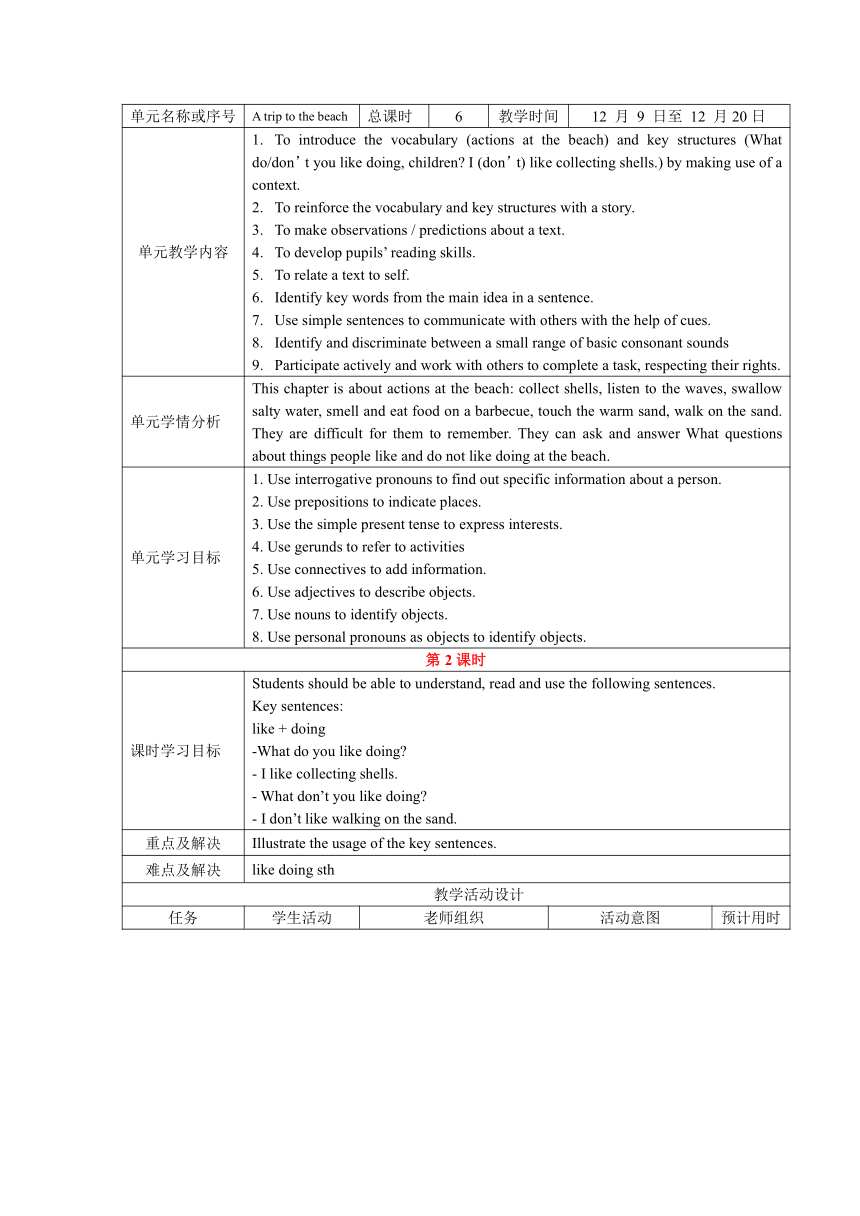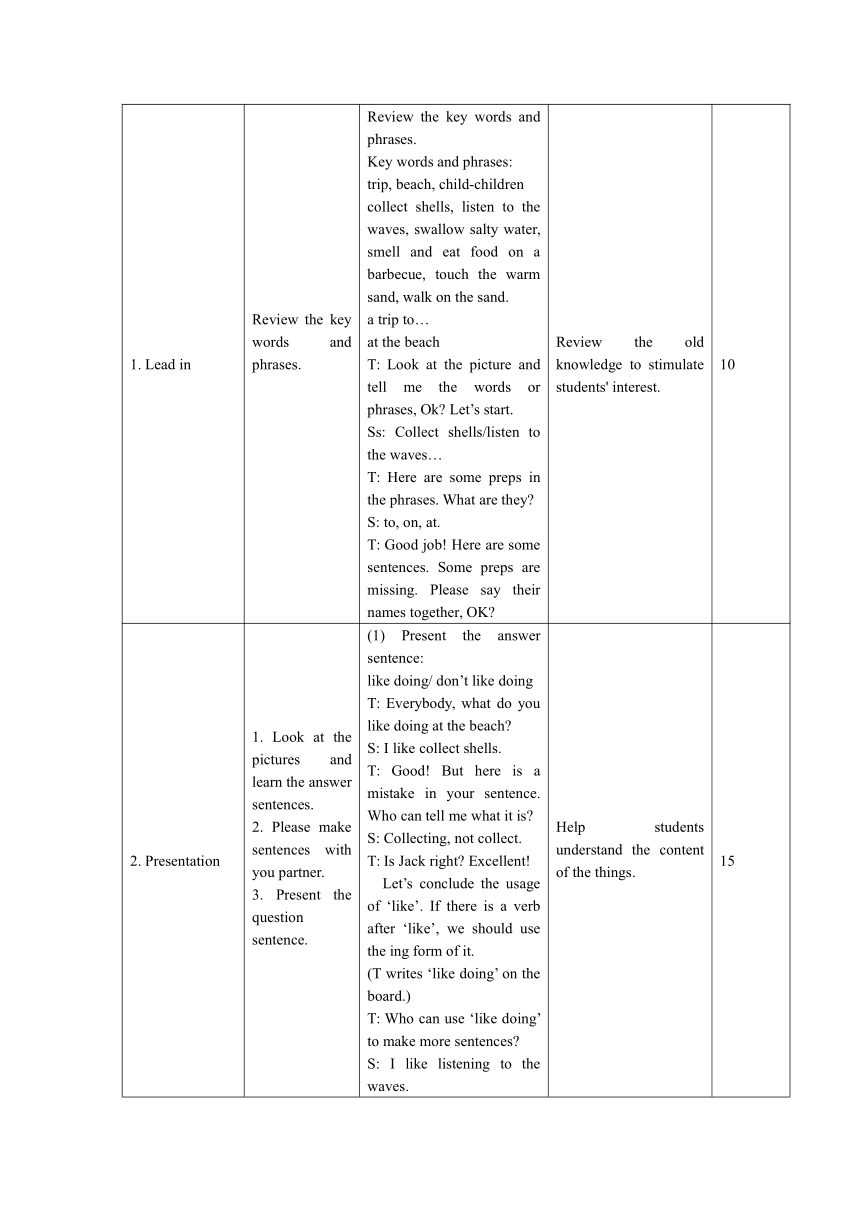Chapter6 A trip to the beach-B全英表格式教案
文档属性
| 名称 | Chapter6 A trip to the beach-B全英表格式教案 |  | |
| 格式 | zip | ||
| 文件大小 | 18.3KB | ||
| 资源类型 | 教案 | ||
| 版本资源 | 其它版本 | ||
| 科目 | 英语 | ||
| 更新时间 | 2023-04-20 15:40:11 | ||
图片预览


文档简介
单元名称或序号 A trip to the beach 总课时 6 教学时间 12 月 9 日至 12 月20日
单元教学内容 To introduce the vocabulary (actions at the beach) and key structures (What do/don’t you like doing, children I (don’t) like collecting shells.) by making use of a context. To reinforce the vocabulary and key structures with a story. To make observations / predictions about a text. To develop pupils’ reading skills. To relate a text to self. Identify key words from the main idea in a sentence. Use simple sentences to communicate with others with the help of cues. Identify and discriminate between a small range of basic consonant sounds Participate actively and work with others to complete a task, respecting their rights.
单元学情分析 This chapter is about actions at the beach: collect shells, listen to the waves, swallow salty water, smell and eat food on a barbecue, touch the warm sand, walk on the sand. They are difficult for them to remember. They can ask and answer What questions about things people like and do not like doing at the beach.
单元学习目标 1. Use interrogative pronouns to find out specific information about a person. 2. Use prepositions to indicate places. 3. Use the simple present tense to express interests. 4. Use gerunds to refer to activities 5. Use connectives to add information. 6. Use adjectives to describe objects. 7. Use nouns to identify objects. 8. Use personal pronouns as objects to identify objects.
第2课时
课时学习目标 Students should be able to understand, read and use the following sentences. Key sentences: like + doing -What do you like doing - I like collecting shells. - What don’t you like doing - I don’t like walking on the sand.
重点及解决 Illustrate the usage of the key sentences.
难点及解决 like doing sth
教学活动设计
任务 学生活动 老师组织 活动意图 预计用时
1. Lead in Review the key words and phrases. Review the key words and phrases. Key words and phrases: trip, beach, child-children collect shells, listen to the waves, swallow salty water, smell and eat food on a barbecue, touch the warm sand, walk on the sand. a trip to… at the beach T: Look at the picture and tell me the words or phrases, Ok Let’s start. Ss: Collect shells/listen to the waves… T: Here are some preps in the phrases. What are they S: to, on, at. T: Good job! Here are some sentences. Some preps are missing. Please say their names together, OK Review the old knowledge to stimulate students' interest. 10
2. Presentation 1. Look at the pictures and learn the answer sentences. 2. Please make sentences with you partner. 3. Present the question sentence. (1) Present the answer sentence: like doing/ don’t like doing T: Everybody, what do you like doing at the beach S: I like collect shells. T: Good! But here is a mistake in your sentence. Who can tell me what it is S: Collecting, not collect. T: Is Jack right Excellent! Let’s conclude the usage of ‘like’. If there is a verb after ‘like’, we should use the ing form of it. (T writes ‘like doing’ on the board.) T: Who can use ‘like doing’ to make more sentences S: I like listening to the waves. T: Well done! Let’s give him a big clap. Look at the picture. How to say this sentence S: I like smelling and eat food on a barbecue. T: Do you agree S:Yes/No. T: Who can correct this sentence S: I like smelling and eating food on a barbecue. T: She says ‘eating’. Do you agree S: Yes. T: Very good! There are two verbs after ‘like’ and linked with ‘and’, so both of these two verbs should be used ing form. Now, please make sentences with you partner. S: (Make sentences with partners.) T: Now, this time, let’s use ‘I don’t like doing’ to make sentences. (2) Present the question sentence: What do you like doing What don’t you like doing T: Look at the dialogue. Some words are missing. Can you tell me what’s missing, Ok (- What ___ you like____ - I like collecting shells.) S: ‘do’ and ‘doing’. What do you like doing T: Well done! Let’s give him a clap. How about this one (- What ___ you like____ - I don’t like collecting shells.) S: ‘don’t’ and ‘doing’. What don’t you like doing T: Fantastic! We learned two questions. Let’s read together. (Teacher writes the two sentences on the board.) T: Now, boys and girls ask and answer questions. Boys ask and girls answer. Help students understand the content of the things. 15
Practice Play the game about ask and answer. Review the spellings of all the phrases together. Game 1: Ask and answer Show students some pictures of different activities they can do at the beach. Ask students to work in pairs to ask and answer. The student who can say it correctly can have one mark. Game 2: Spelling game Try spelling the sentences. By playing the games students can further understand the content of the dialogue, internalize the language, and lay the foundation for language output. 10
Consolidation Fill the blanks of the sentences. Fill in the blanks. E.g: (1) I like _____shells. (2) She likes ______ to the waves. (3) He likes ______salty water. (4) Tom doesn’t like ______ on the sand. (5) Lucy doesn’t like ______warm sand. (6) What don’t you like ______ at the _____ Help pupils master the main points better in this class. 5
作业设计
Try to recite the contents of Part A-B. Prepare the contents of Part C.
板书设计
Chapter6 A trip to the beach Key sentences: like + doing -What do you like doing - I like collecting shells. - What don’t you like doing - I don’t like walking on the sand.
单元教学内容 To introduce the vocabulary (actions at the beach) and key structures (What do/don’t you like doing, children I (don’t) like collecting shells.) by making use of a context. To reinforce the vocabulary and key structures with a story. To make observations / predictions about a text. To develop pupils’ reading skills. To relate a text to self. Identify key words from the main idea in a sentence. Use simple sentences to communicate with others with the help of cues. Identify and discriminate between a small range of basic consonant sounds Participate actively and work with others to complete a task, respecting their rights.
单元学情分析 This chapter is about actions at the beach: collect shells, listen to the waves, swallow salty water, smell and eat food on a barbecue, touch the warm sand, walk on the sand. They are difficult for them to remember. They can ask and answer What questions about things people like and do not like doing at the beach.
单元学习目标 1. Use interrogative pronouns to find out specific information about a person. 2. Use prepositions to indicate places. 3. Use the simple present tense to express interests. 4. Use gerunds to refer to activities 5. Use connectives to add information. 6. Use adjectives to describe objects. 7. Use nouns to identify objects. 8. Use personal pronouns as objects to identify objects.
第2课时
课时学习目标 Students should be able to understand, read and use the following sentences. Key sentences: like + doing -What do you like doing - I like collecting shells. - What don’t you like doing - I don’t like walking on the sand.
重点及解决 Illustrate the usage of the key sentences.
难点及解决 like doing sth
教学活动设计
任务 学生活动 老师组织 活动意图 预计用时
1. Lead in Review the key words and phrases. Review the key words and phrases. Key words and phrases: trip, beach, child-children collect shells, listen to the waves, swallow salty water, smell and eat food on a barbecue, touch the warm sand, walk on the sand. a trip to… at the beach T: Look at the picture and tell me the words or phrases, Ok Let’s start. Ss: Collect shells/listen to the waves… T: Here are some preps in the phrases. What are they S: to, on, at. T: Good job! Here are some sentences. Some preps are missing. Please say their names together, OK Review the old knowledge to stimulate students' interest. 10
2. Presentation 1. Look at the pictures and learn the answer sentences. 2. Please make sentences with you partner. 3. Present the question sentence. (1) Present the answer sentence: like doing/ don’t like doing T: Everybody, what do you like doing at the beach S: I like collect shells. T: Good! But here is a mistake in your sentence. Who can tell me what it is S: Collecting, not collect. T: Is Jack right Excellent! Let’s conclude the usage of ‘like’. If there is a verb after ‘like’, we should use the ing form of it. (T writes ‘like doing’ on the board.) T: Who can use ‘like doing’ to make more sentences S: I like listening to the waves. T: Well done! Let’s give him a big clap. Look at the picture. How to say this sentence S: I like smelling and eat food on a barbecue. T: Do you agree S:Yes/No. T: Who can correct this sentence S: I like smelling and eating food on a barbecue. T: She says ‘eating’. Do you agree S: Yes. T: Very good! There are two verbs after ‘like’ and linked with ‘and’, so both of these two verbs should be used ing form. Now, please make sentences with you partner. S: (Make sentences with partners.) T: Now, this time, let’s use ‘I don’t like doing’ to make sentences. (2) Present the question sentence: What do you like doing What don’t you like doing T: Look at the dialogue. Some words are missing. Can you tell me what’s missing, Ok (- What ___ you like____ - I like collecting shells.) S: ‘do’ and ‘doing’. What do you like doing T: Well done! Let’s give him a clap. How about this one (- What ___ you like____ - I don’t like collecting shells.) S: ‘don’t’ and ‘doing’. What don’t you like doing T: Fantastic! We learned two questions. Let’s read together. (Teacher writes the two sentences on the board.) T: Now, boys and girls ask and answer questions. Boys ask and girls answer. Help students understand the content of the things. 15
Practice Play the game about ask and answer. Review the spellings of all the phrases together. Game 1: Ask and answer Show students some pictures of different activities they can do at the beach. Ask students to work in pairs to ask and answer. The student who can say it correctly can have one mark. Game 2: Spelling game Try spelling the sentences. By playing the games students can further understand the content of the dialogue, internalize the language, and lay the foundation for language output. 10
Consolidation Fill the blanks of the sentences. Fill in the blanks. E.g: (1) I like _____shells. (2) She likes ______ to the waves. (3) He likes ______salty water. (4) Tom doesn’t like ______ on the sand. (5) Lucy doesn’t like ______warm sand. (6) What don’t you like ______ at the _____ Help pupils master the main points better in this class. 5
作业设计
Try to recite the contents of Part A-B. Prepare the contents of Part C.
板书设计
Chapter6 A trip to the beach Key sentences: like + doing -What do you like doing - I like collecting shells. - What don’t you like doing - I don’t like walking on the sand.
同课章节目录
